A few days ago I was running through twitter when I saw Peter Cohen (@flargh) link to a blog post he had written about distraction free writing and the focused simplicity of a 30 year old word processor. Reading the article, I began to reflect upon the word processors that I — personally — have used over the past 35 years and it inspired me to write a little about a few of those that stand-out in my mind. (I should underscore the fact that this post is not meant to be a look at the overall evolution of the word processor, but a look back at my own experiences over the years.)
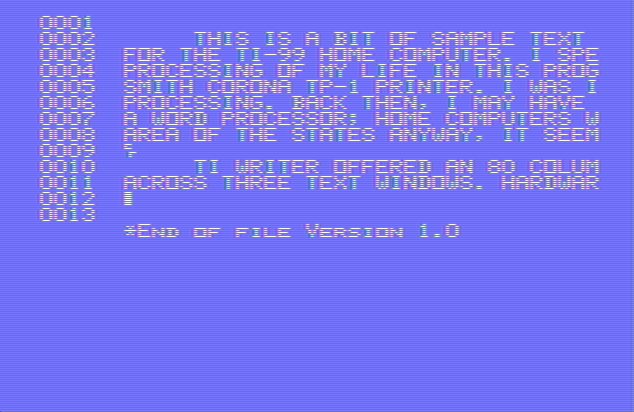
TI Writer on the TI-99/4A (1983) — My first computer, the TI-99/4A, was nice for games and educational programs, but wasn’t the ideal word processing platform. Wanting to start using a word processor for my school reports (6th grade), I made the obvious choice to go with TI Writer, a combination cartridge and disk program that output to a printer tied to the RS-232 interface card (if you had one). The TI could only generate a 40-column display, but TI Writer delivered a virtual 80-column page that could be viewed using a left, middle, and right panning window — a bit cumbersome, indeed. I had a Smith-Corona TP-1 daisywheel printer hanging off of that board’s parallel port and became one of the very first kids in my class to hand work in done on a home computer. (Screenshot shows the first 1/3 of the 80-column sample document I created for this post.)
![]()
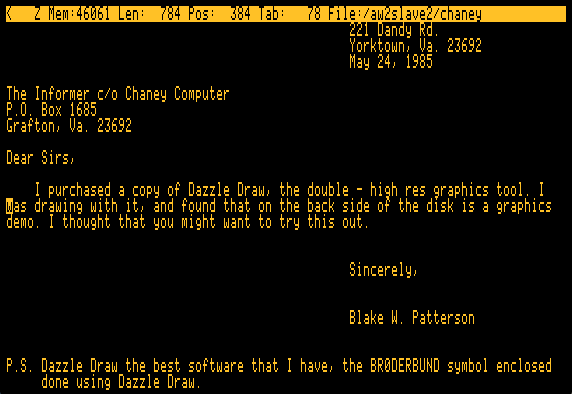
Apple Writer II on the Apple //c (1984) — My next computer was the Apple //c which I got right after it launched in early 1984. And it had 80 column text! The go-to word processor at that time was Apple Writer II, which was simple but functional — a dream compared to TI Writer! I had an Apple ImageWriter printer for output. (Screenshot shows a document I recently found on my 32-year-old Apple Writer II data disk.)
![]()
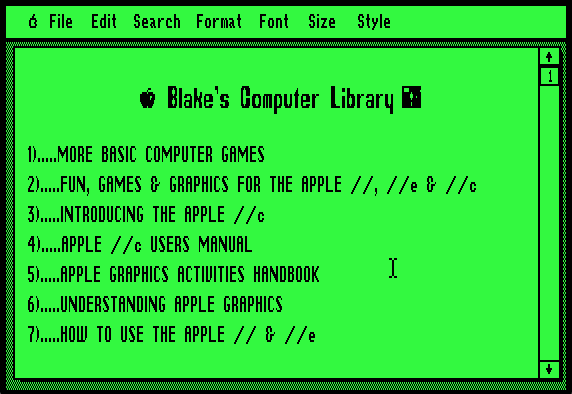
MultiScribe on the Apple //c (1985) — After getting a mouse for the //c, I was able run StyleWare’s new MultiScribe WYSIWYG word processor. I was lusting for a Macintosh at the time and this felt like something of a bridge to that world of bitmap graphics and fancy fonts. Its output to a dot-matrix printer was pretty rough looking, however. As such, I didn’t get much serious work done with this one. (Screenshot shows another document I recently found on my 32-year-old Apple Writer II data disk.)
![]()
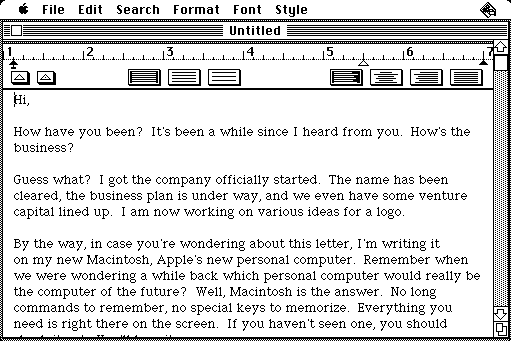
MacWrite on a Macintosh 128K (1985) — Now this is where I was trying to be, using MultiScribe on the //c. I finally got a Macintosh, and it came with MacWrite and MacPaint. I never did any real word processing on the Mac, however, because a week after getting it I saw an Amiga 1000 on display at the local computer shop, returned the Mac, and put an order in for the Amiga. I never even had a printer hooked to that Mac! In the early ’90s I bought a Macintosh LC and used a much later version of MacWrite on that machine during part of college. I even made some money doing page layout for students with that LC, MacWrite, and my StyleWriter printer.
![]()
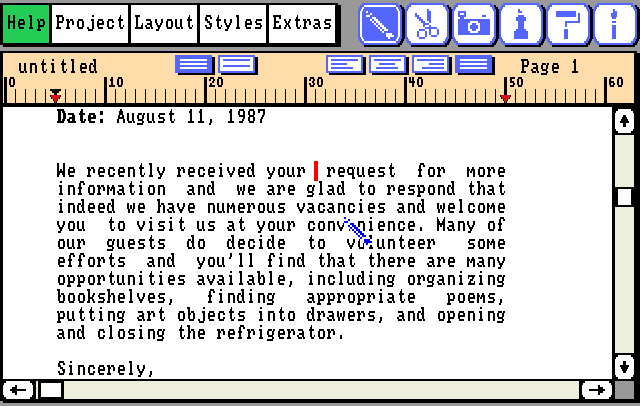
Textcraft on the Amiga 1000 (1986) — To say that software was slow to come for the Amiga after its late 1985 launch is an understatement. I had two different printers hanging off of my A1000 (an Epson LX-80 and a color Okimate 20) and for many months my only “word processor” was the extremely basic Notepad bundled with AmigaDOS. Finally I got Textcraft, made by Arktronix (who created the notable but unsuccessful windowed word processor suite, Jane). It was a proper word processor, rather basic, but it helped me get the schoolwork done. (Screenshot courtesy of Paul Ford.)
![]()
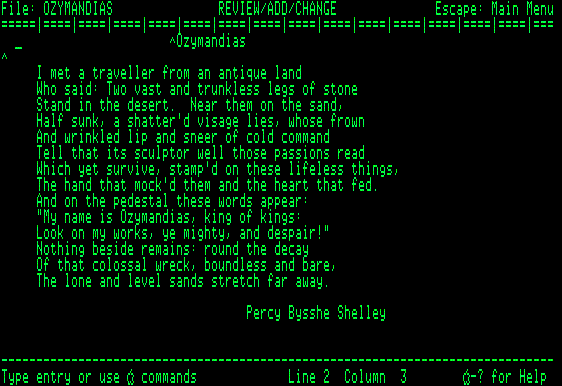
AppleWorks on the enhanced Apple IIe (1986) — What an odd move! I sold my Amiga and went back to the Apple II! It was Apple Garamond that made me do it. At any rate, Apple’s integrated word processor, database, and spreadsheet suite was the thing to use at this point. We used AppleWorks in school and it was a surprisingly rich little package with a number of expansion tools made available by third parties. I used Pinpoint, I recall. I had an Apple ImageWriter II printer as part of this setup.
![]()
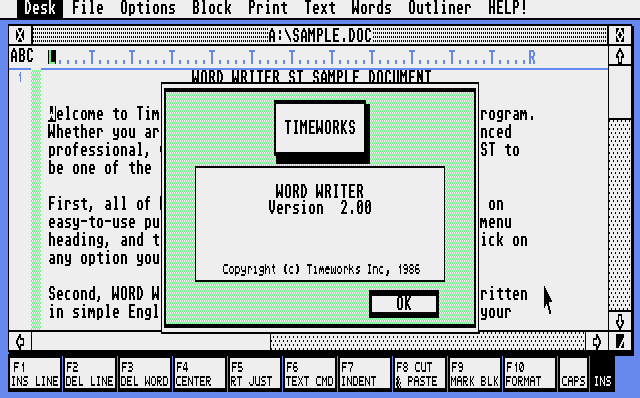
Word Writer ST on the Atari 520ST (1987) — The most popular word processor for the Atari ST was Atari’s own 1st Word, but it felt quite basic to me, so I went with Timeworks’ Word Writer ST, which is the first word processor I ever used that came with an integrated spell checker. Like 1st Word, Word Writer ST utilized the windowed GEM user interface of the Atari ST, though it was not a multi-font, WYSIWYG editor. I used an Epson LX-800 and an Okimate 20 printer with this setup.
![]()
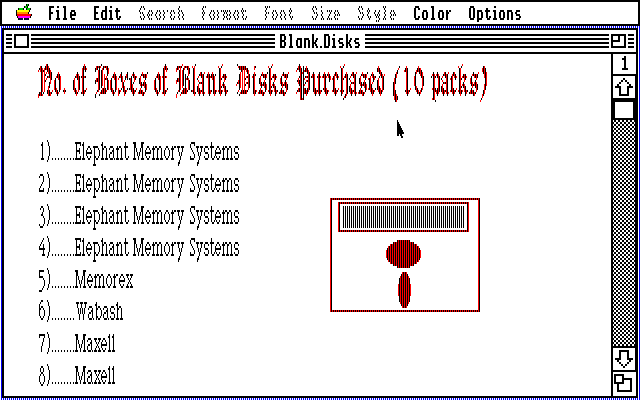
MultiScribe GS on the Apple IIgs (1988) — I did most of my word processing on the Apple IIgs using the aforementioned, 8-bit AppleWorks, as it’s what we had in the Apple lab at school. I was friends with the guys at the local dealer where I purchased the GS system and a salesman gave me copies of dealer versions of various IIgs applications, MultiScribe GS among them. I used it for a good many things. It’s print output, with color on the ImageWriter II, was quite nice. This felt like a Mac app. (Screenshot shows yet another document I recently found on my 32-year-old Apple Writer II data disk.) Incidentally, a WordPerfect rep came and spoke at our local Apple user group around this time and I won a boxed copy of WordPerfect for the IIgs (as well as a large, brass WordPerfect keychain) for correctly answering trivia questions concerning the history of the product. (I was off-the-leash as a 16-year-old, it’s clear to see.) I loaded it up a few times but never used it for more than a homework assignment or two.
![]()
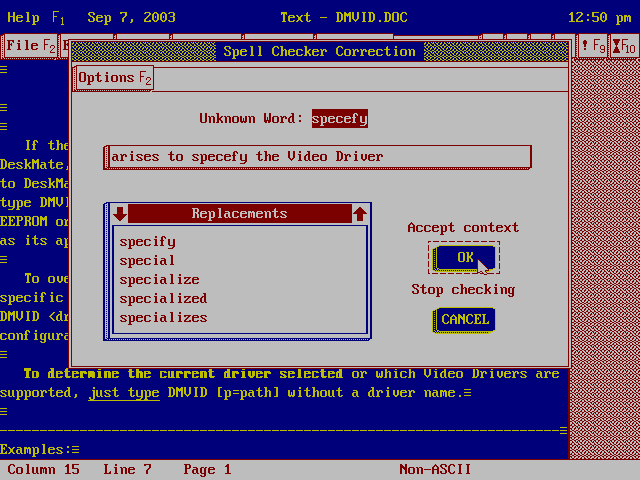
DeskMate on the Tandy 1000TL (1989) — DeskMate was Tandy’s own bundled app suite that came with every Tandy PC-compatible. It featured a spreadsheet, database, calendar, and word processor, with later versions seeing the inclusion of audio and drawing modules. It worked fine, but all parts were rather basic and I never liked the overall feel of the thing; it was rendered in a graphics mode but looked like nothing more than some kind of enhanced ANSI text. Still, while I was driving the 1000TL I used DeskMate‘s word processor to get things written.
![]()
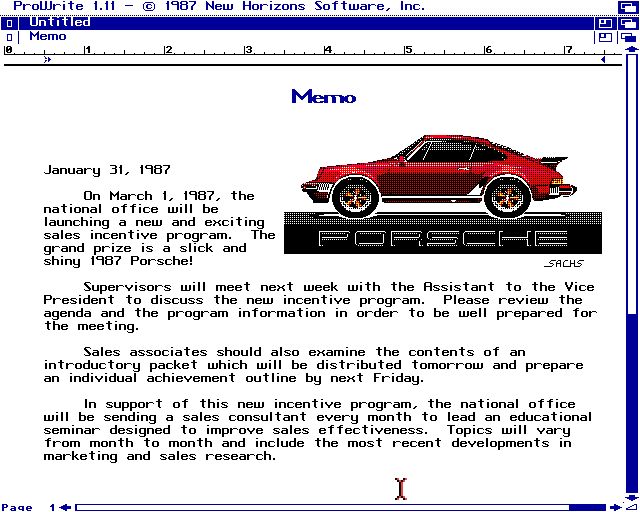
ProWrite on the Amiga 2000 (1989) — ProWrite was the WYSIWYG word processor of choice for the AmigaDOS 1.3-era Amigas. I used this on my Amiga 2000 at the end of high school and in early college, and really put it through its paces. This is the first setup where I experienced something akin to today’s web distraction; I’d be working on a paper and then switch over to browsing dialup BBS forums and back again. I printed documents on an Epson LX-800 dot-matrix printer.
![]()
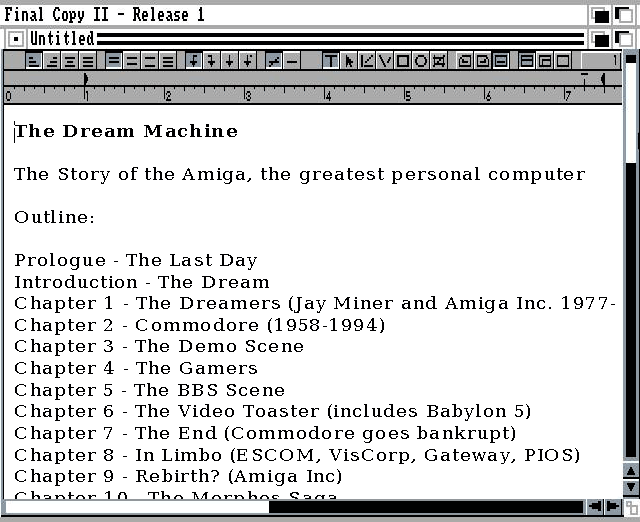
Final Copy II on the Amiga 1200HD (1993) — One of the nicest word processors for AmigaDOS 2.x era Amigas was SoftWood‘s Final Copy II. It had a very clean interface, was fairly feature rich, and was responsive to use on standard config hardware. Final Copy II supported both the standard Amiga Compugraphic outline fonts as well as PostScript Type 1 fonts. I printed out my work on the excellent Epson Action Printer 3250 24-pin printer.
![]()
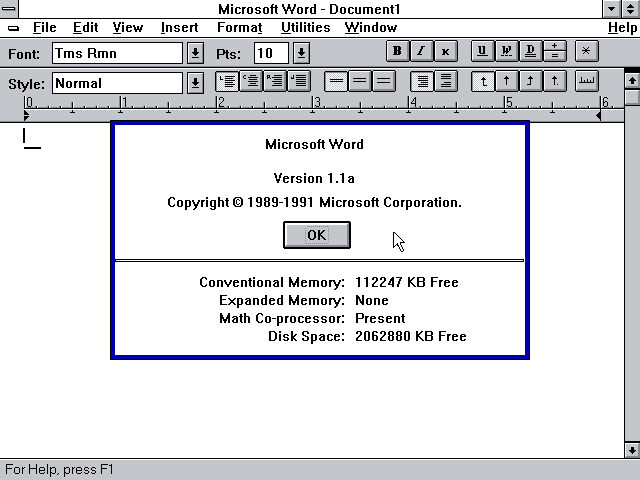
Microsoft Word for Windows on the 486 66 PC (1994) — And, of course, we come to this. Microsoft Word. I ran this on my eCesys 486 66 PC under Windows 3.1 as well as under Windows 95. (How I came by owning the Windows version of Word is an interesting story.) Later, I ran it on my Macs from the Power Macintosh G3 up through my current iMac desktop, and on my work PC and MacBook Pro at the office. I don’t do much word processing these days, but when I do it’s usually in Word. The days of competing word processors really ended after Word had been on the market for a few years.
I’ve not listed every word processor I’ve ever used on the various systems I’ve owned over the years, but these are the ones that stand out the most to me. As mentioned above, when I do have a need to use a word processor, I typically use Word. I own Pages for OS X and use it here and there, but really my processing of words mostly involves code and code editors like VSCode and Sublime Text. Growing up, my wife used WordStar on the family’s Kaypro and WordPerfect during college and law school on a DOS laptop. My 10-year-old daughter started using a word processor three years younger than I did, and it’s not even a traditionally executing application; she uses Google Docs on her Chromebook, as per her school.
The area of computing that is word processing used to be quite an eclectic field, and I suppose that makes sense given that the early era of home computing was, in most ways, exactly that. Today we have a narrow spectrum of both computing platforms and word processors. They are all feature rich and (more or less) stable, but the field is less interesting, less exciting overall.
Ah, but for the days when word processing was an adventure.

what about Tasword?
Awesome list! I also remember Wordstar on the Osborne I and the DecMate I word processor!
Nice trip :-)
For me it was VIP Writer III on the CoCo 3 that carried me over college, all my previous hardcopy jobs were done on a tried and true typewriter and the then fledgling Word Perfect on a IBM PC at the school’s lab. One develops an attachment to one WP system and VIP stuck with me even as I started my professional life. The later part of school had me using Max-10 on the CC3, one hell of a WYSIWYG WP for the platform.
In 2013, somebody spoke of difficulties printing a document properly. On following up, I found that she was using WordPerfect; she did not care for my suggestion that she import her document into Word. This would have thrown off the alignment of a table, I think, not that the table printed quite properly as it was. I suspect that if I went through the organization inquiring closely, I could find a handful of lawyers and legal secretaries still using WordPerfect. It was, I recall, WordPerfect’s footnoting that made the legal world love it.
WordPerfect was (is?) great. I remember installing the DOS version back in the late eighties from 5.25” floppy disks. In addition to the disks that held the application, there were (approximately) a zillion disks with printer drivers for every imaginable printer.
At a later job, we had WordPerfect running on HP-UX servers with people using it over terminals, which we replaced with PCs running Windows, and, finally, the Windows version of WordPerfect, which was light years ahead of Word at the time. In addition to the footnoting and citation support, WP had super powerful macros that would let people do complex things really easily, and that was one of the major features used by legal folks.
The killer feature for me was the reveal codes feature, which let you see why your italics, bold, and normal text were all screwed up, and easily fix it, in some ways making it a bit more like using a markup language.
There was also, for a little while, a version for Mac OS 7/8/9, which worked pretty much identically to the Windows version, but still fit into the Mac environment way better than Word did (maybe still better now).
I don’t really like word processors (I switched to LaTeX and never looked back), but if there was a macOS WordPerfect, I’d buy it in a heartbeat.
What about the VI editor? lol :-)
Not for word processing. But a great text editor.
Wordstar->Ability->Locoscript->Wordperfect 5.1-> VIM and Latex
I was hoping someone would mention WordStar. I had an old Osborne I portable computer and it came with WordStar, SuperCalc, and BASIC. It came out in 1981.
For retro word processing, mostly used Word Perfect on the Atari ST.
My favorite old word processor was WriteNow 4.0 for Macintosh. I also used MS Word 5.0 and MacWrite.
Protext on the Amstrad CPC running on CPM+
You’re saying “Final Copy II on the Amiga 1200HD (1993)”. Looks like WB 1.3 or something to me alright.
Good eye. That’s a screenshot I grabbed from the web, not having made my own way back when. I ran the program under Workbench 3.x, on my A1200HD, though.
Yep, OK. I personally find the text in interlaced HiRes very hard to read, not because of possible flicker, since that can be avoided by certain means, but since the letters will often only be one pixel thick. Old eyes here, haha. On the other hand the text will of course look better than in non-interlaced HiRes overall. Now one-pixel thick text will look fatter on a CRT display than on a LCD display as well, so that will affect it too, of course.
I often would prefer ~640×200 than interlaced 640×400 for wp, but it depends on the system. Look at the IIgs screenshot up there. The GS basically used Mac bitmap fonts but at 200p it rendered them twice as tall as they would appear on page, and that was a bother. Of course, the GS didn’t offer a 400i mode at all, so there was no option, really.
Anyone remember the name of the bundled software package around 1990 that had a word processor, spreadsheet and database?
It came about five years earlier but Apple offered AppleWorks for the Apple II line, which was an integrated suite of the three apps you mention. It’s shown within this post. The Commodore Plus/4 unit, released in 1984, featured such a suite in ROM, though it was extremely basic.
There’s Microsoft Works from 1988 and Microsoft Office, which debuted in 1990. I’m sure there are others.
WordPerfect Office came out in 1993, which included WordPerfect, Quattro Pro (spreadsheet) and Paradox (database).
Enable.. 1986? Loved it! 300pg instruction book.
I ran “Pen Pal”, a combination word processor, database and page layout package. I produced our Amiga User Group newsletter for two years using this software on my Amiga 500 with 2 meg of ram. Output was to a 24 pin Citizen color (ribbon style) printer. The newsletter was of course done with the black ribbon.
Oh wow — I think I forgot that I actually had and used Pen Pal for a while on my A2000! In the US it was published by SoftWood and I recall that SoftWood also sold an Apple IIgs application called SoftWood GSFile, which was a DB app for the IIgs. I always wondered if they were written by the same dev group, but looking now I’m doubting that was the case.
http://www.classicamiga.com/content/view/4618/175/
http://www.whatisthe2gs.apple2.org.za/softwood-gsfile
I am 82 and I am a greeting card maker. I loved making my cards personal. So I set up pages in the sizes I used most often. IT SAVED THE SETTINGS. NOT ANYMORE!!! We had wonderful variety of fonts. NOT ANY MORE
I especially miss the tool feature that asked for a shape. I wanted to design a special printing for a family reunion. I pickked a circle to be made into a rememberance button. I clicked on tools…picked my shape….circle…add your text…AND IT DID IT!!! Word 10 is hopeless for me
Very good article. I am going to mention a word processor that was not commented: GeoWrite that came included in the GEOS operating system for Commodore 64 and Commodore 128. If you look at it, it has a certain similarity with AppleWrite. A few years later, the GeoWrite developers produced a version of GEOS for Apple 2 computers.
Am familiar with GeoWrite, thanks. I know a number of Apple II folks that loved it. It ran at a very nice 560×192 res on the enhanced IIe and //c. I have a mountable volume with all of GEOS and the apps on my IIe’s CFFA3000 flash, but sadly GEOS won’t recognize the mouse card sitting in slot 7 (surely it wants it in slot 4, but for reasons, the Mockingboard C is staying there). Wish I knew of a patch version so I could run GEOS properly.
Way back in the day, I used to write GEOS columns for Computer Shopper. Thanks for bringing back those memories!
Yeah! GeoWrite was my first expérience, on my 286/20 1Mo !
I was surprised to discover at school in the same time that MS Word under DOS wasn’t WYSIWYG like GeoWrite! Even TrueType support! GEOS was an excellent solution, even for slow machines with little RAM!
Pingback: Timeless Information - Lexon Information Management Strategy
A great word processor and chart maker in the 80s was Ami-Pro, back in the days of the Lotus 1-2-3 spreadsheet software.
Hi folks. I don’t know how far you go back in the world of computers but my first job in the field was as a hardware maintenance engineer for Cap Industry which later merged with Sema Metra to become Sema Group which then was taken over by AtosOrigin all here in the UK. My first repairs were very much in the mid range and larger computer spheres and mostly dumb terminals but there was one device that the secretaries had which was a diecast aluminium shell that contained a dedicated processor and housed a full height 10MB RLL hard disc and connected to a dumb terminal in a similar metal shell cased box on a cup type stand that allowed you to move it around just about anywhere. The cases of both were cream colour with a black screen bezel and they really only did word processing that was somewhat like wordstar and displayed green text on the screen on a black background. They were made if I remember correctly by a company called Comart with things connected via a serial RS232 cable. Beyond that we also had Zilog machines running accounts and a large line printer for the reports that came out of it. The Zilog was connected serially via a Racal Milgo Planet distributed network that had dual rings running a 9Mhz that had over 200 serial nodes connected to it. Accounts was run with the aid of our one and only database and Zilog specialist who dealt with all the machines across the company in 9 different country wide locations. It was a time when we were buying IBM XT clone machines and wonder of wonders they ran a 4.7Mhz and seemed so much better than the Comarts! WordPerfect 4.2 on a 20MB hard disc running DOS3.2 with menu’s created by me such that the staff could go easily between applications via a simple number key entry system so Procomm+ terminal access software, Drawperfect, Planperfect and Wordperfect as well as Lotus 123. Ah such memories!
If I remember correctly they were an s100 bus system with a Z80 processor dating from the late 1970’s
Does anyone remember ETG Editing, Text, and Graphics? I had it on an 8088 Pc clone with Dos 3.2 in the 1980s. I had a word processor that I used to do my homework on. It was such a simple program and easy to use. I had a Norton commander like interface. I’ve never heard of anyone else using it.
I used it on a Franklin PC8000 clone from Sears. Started my first novel on it. Got it for free from my public library. Much better, IMHO, than Windows 1.0 (which I tried running on the same machine, futilely).
Under the “does anyone remember” heading: Wordproof. I don’t know who put it out back in the ’80s but I have found no references to it on the www. It was, as I recall, a simple, no-frills word processor and was ideal for writing dBASE III+ (also ancient history) code because there was no formatting of the text. Of course, the copy I have in the archives ran on DOS but windows has no idea what to do with it. Does anyone else remember this simple word processor?
What year are brother WPs?
Well, the Brother WP-80 is from ~1992. I remember a friend of mine who went to college and was a console gamer (I think he was on Saturn and 32X at the time — big Sega guy) but had no actual computer. He bought one of these to get him through college. I recall building a PC for him when he started law school, but that Brother took him through college fine. (Looking at you, Eric.)
I used Wordstar in 1983-1985. It ran in the CP/M operating system on the Monroe OC8820 computer. I worked for Monroe Systems for Business (since returned to their old name, Monroe Calculators). The computer resembled the Radio Shack TRS-80 as it was an all-in-one unit. Wordstar was easy and efficient back in the day.
Yes, I was handing in essays written on a word processor like a champ back in the 80’s. SuperScripsit, TRS-80 Model III.
Atari’s 1st Word on the 520ST was my upgrade from there.
After that I lost interest for a while, and then I made this post.
I could be leaving a few things out.
My preferred word processor is Codelobster – https://codelobster.com
There was a Desk Top unit in the 1980s
Dedicated hardware to word processing
CRT mounted in Portrait position
Quite expensive
Can’t remember the name
Not a Wang
I was directed here from my search, “What spreadsheet program was usually bundled with WordPerfect” It didn’t exactly answer that, but I enjoyed the history (shortly after the time when computer people were either operators or programmers. My brain glazed over when my boyfriends started talking about computers (and somehow I ended up with a few computer-phile boyfriends in a row) Now I’m the one people ask to look something up online.
Looking through these, I remembered the end of Doogie Houser, M.D. episodes, when he wrote about his day. I always wanted to know what program he used. Do you happen to know what it was?
About once per month, getting less frequent as time goes by, I find a corner of the internet that reminds me of what the internet was, and what it could have been.
Thanks for this.
I came here trying to remember the name “FrameMaker”. I loved using that product on SparcStations. I would go back to it in a heartbeat versus Word.
I was led down this rabbit hole trying to imagine how much of my life has been spent dealing with auto-format in Word. I’m sure it’s got to be near a year. Hopefully an AI augementation of Word helps them improve a product most of us drones have to use, and which they otherwise seem content to maintain as terrible forever.
I used Word Perfect as a contract worker at a manufacturing company in 1990. It did a lot of great things Microsoft Word 2.0 for Dos (pre-windows) couldn’t do. When I started to work as a clerk at Boeing in 1991, and they sent me for training on MSWord 2.0, the instructor would say things like, Deb won’t be impressed with this one because she got to use Word Perfect 5.0 and it was better”. Word Perfect was way ahead of MSWord, but Microsoft was the better marketer because of including Excel and Access. They ran Word Perfect out of business. Eventually, Microsoft added lots of cool stuff, some of which they’ve dropped over the years (very disappointing).
This was a great trip down memory lane! I actually came here looking for the name of a bundled suite of programs (circa 1997) in Windows that *wasn’t* Word… someone mentioned AppleWorks and it jogged my memory of MSWorks! It was like a ‘Lite’ version of the Microsoft Office suite.
Pingback: Altes Textverarbeitungsprogramm: gesucht und gefunden – LehrerInnenZimmer
I’m looking for screenshots of ETG pkus Easy Text and Graphics and it seems impossible to find anything. Does anyone know where I could find some screenshots or anything?